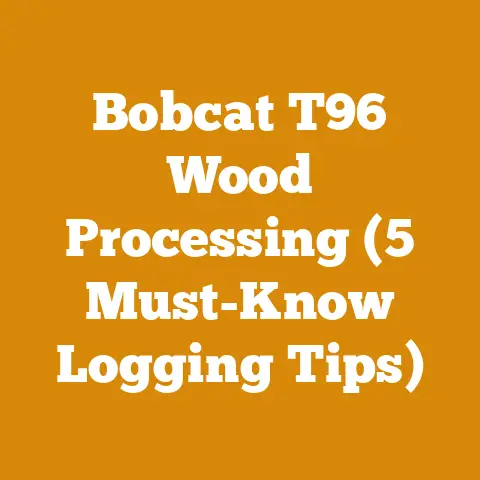Using Douglas Fir Outside (5 Pro Tips for Durable Wood Posts)
Have you ever felt the sting of disappointment when a project you poured your heart and soul into, painstakingly crafted with wood, succumbs to the relentless forces of nature?
I have.
More times than I care to admit.
Seeing rot creep in, the wood warp and crack, is a disheartening experience.
That’s why, over years of working with wood, both as a hobbyist and on larger-scale projects, I’ve learned the hard way that choosing the right wood and treating it properly are absolutely crucial, especially when it’s going to be exposed to the elements.
Douglas Fir, with its beautiful grain and relative affordability, is a popular choice for outdoor projects.
But let’s be honest: left untreated, it’s not going to last.
That’s why I’ve put together these five pro tips, born from my own trials and errors, to help you ensure your Douglas Fir posts stand the test of time.
We’ll also delve into the costs associated with using Douglas Fir, from the timber itself to the various treatments and tools involved, because, let’s face it, nobody wants a project to break the bank.
Using Douglas Fir Outside (5 Pro Tips for Durable Wood Posts)
Douglas Fir is a softwood known for its strength, straight grain, and availability.
It’s a great option for posts, fences, and other outdoor structures, but it requires proper preparation to withstand the elements.
These five pro tips will help you maximize its lifespan and minimize the risk of rot and decay.
1. Choose the Right Grade of Douglas Fir
Not all Douglas Fir is created equal.
The grade of lumber significantly impacts its durability and suitability for outdoor use.
This is where understanding the nuances of lumber grading becomes essential, and where I’ve learned a few costly lessons myself.
- What to Look For: Aim for at least a “Construction” grade, but ideally, opt for “Select Structural” or “Dense Select Structural.” These grades have fewer knots, tighter grain, and are generally stronger and more resistant to warping and decay.
- Why it Matters: Lower grades (like “Standard” or “Utility”) may contain more imperfections and are more susceptible to moisture damage.
While they might seem like a cost-effective option upfront, they’ll likely cost you more in the long run due to premature failure and the need for replacement. - Cost Considerations: Expect to pay a premium for higher grades.
The price difference between “Construction” and “Select Structural” can be significant, potentially adding 10-30% to your lumber cost.
However, consider this an investment in longevity. - Real-World Example: I once tried to save a few bucks on a fence project by using “Standard” grade Douglas Fir for the posts.
Within two years, several posts had begun to rot at the ground line, requiring costly repairs and replacements.
Lesson learned: quality matters!
Data Point: According to a recent report by the North American Wholesale Lumber Association (NAWLA), the average price difference between “Construction” and “Select Structural” Douglas Fir can range from $100 to $300 per thousand board feet, depending on region and market conditions.
2. Treat the Wood Thoroughly
Even the best grade of Douglas Fir needs protection from moisture, insects, and fungi.
Proper treatment is non-negotiable for outdoor applications.
There are several treatment options available, each with its own set of pros, cons, and costs.
Cost Breakdown Example:
Let’s say you’re building a fence with 4×4 Douglas Fir posts, each 8 feet long.
You need 20 posts.
- Untreated Douglas Fir (Construction Grade): $15 per post = $300
- Pressure-Treated Douglas Fir: $25 per post = $500
- Cost Difference: $200
While the pressure-treated option is more expensive upfront, it will likely save you money in the long run by preventing costly repairs and replacements.
If you opt for untreated Douglas Fir and brush-on preservatives:
- Untreated Douglas Fir (Construction Grade): $15 per post = $300
- Copper Naphthenate (1 gallon): $30 (enough for 2 coats on all posts)
- Brushes and Supplies: $20
- Total Cost: $350
Remember to factor in the cost of reapplication every few years.
Data Point: A study by the Forest Products Laboratory found that pressure-treated wood can last 20-30 years or more in ground contact, while untreated wood may only last 5-10 years, depending on the environment.
3. Pay Attention to End Cuts
The end grain of wood is particularly vulnerable to moisture absorption.
When water penetrates the end grain, it can quickly lead to rot and decay.
This is an area that’s often overlooked, but it’s critical for long-term durability.
- How to Protect End Cuts: After cutting your Douglas Fir posts to length, immediately treat the end cuts with a generous application of a wood preservative.
Apply several coats, allowing each coat to dry before applying the next. - Use a Specialized End-Cut Preservative: These products are formulated to penetrate deeply into the end grain and provide extra protection.
They often contain higher concentrations of preservatives than general-purpose treatments. - Consider End Caps: For added protection, you can install plastic or metal end caps on the tops of the posts.
These caps will prevent water from pooling on the end grain and further reduce the risk of rot.- Cost: End caps typically cost $2-5 per cap.
- Angle the Tops: Cutting the tops of the posts at a slight angle will help water run off and prevent it from pooling.
My Biggest Regret: I once built a pergola with beautiful Douglas Fir posts, but I neglected to properly seal the end cuts.
Within a few years, the tops of the posts were showing signs of rot, and I had to cut them off and install new caps.
Now, I always make sure to give the end cuts extra attention.
Data Point: Research has shown that properly sealing end cuts can increase the lifespan of wood posts by up to 50%.
4. Ensure Proper Drainage
Water is the enemy of wood.
Poor drainage around your Douglas Fir posts will accelerate the decay process.
Here’s how to ensure proper drainage:
- Use Gravel at the Base of the Hole: When setting the posts in the ground, dig the holes deeper than necessary and fill the bottom with several inches of gravel.
This will allow water to drain away from the base of the post and prevent it from sitting in standing water. - Create a Concrete Collar: Encasing the base of the post in concrete can help protect it from moisture and insects.
However, it’s important to ensure that the concrete is properly sloped away from the post to allow water to drain.- Cost: A bag of concrete mix typically costs $5-10.
You’ll need approximately one bag per post, depending on the size of the hole.
- Cost: A bag of concrete mix typically costs $5-10.
- Use Post Anchors: Post anchors are metal brackets that elevate the post above the ground, preventing it from coming into direct contact with moisture.
This is an excellent option for decks, fences, and other above-ground structures.- Cost: Post anchors range in price from $10 to $50 per anchor, depending on the size and style.
- Avoid Planting Directly Against the Posts: Plants can trap moisture against the wood and create a favorable environment for rot and decay.
A Costly Oversight: I once installed a fence without paying attention to drainage.
The area was prone to flooding, and the posts were constantly sitting in water.
Within a few years, the posts had rotted at the ground line, and I had to replace the entire fence.
Now, I always make sure to address drainage issues before installing any wood posts.
Data Point: Studies have shown that proper drainage can extend the lifespan of wood posts by 2-3 times.
5. Maintain and Inspect Regularly
Even with the best preparation, your Douglas Fir posts will require regular maintenance and inspection.
This will help you identify and address any potential problems before they become serious.
- Inspect Annually: At least once a year, inspect the posts for signs of rot, decay, insect infestation, or damage.
Pay close attention to the ground line, where moisture is most likely to accumulate. - Reapply Preservative: Depending on the type of preservative you used, you may need to reapply it every few years.
Follow the manufacturer’s instructions for reapplication. - Clean the Posts: Regularly clean the posts with a brush and mild detergent to remove dirt, debris, and mildew.
- Repair Damage Promptly: If you notice any damage, such as cracks, splits, or insect holes, repair it promptly to prevent further deterioration.
Use a wood filler or epoxy to fill cracks and holes. - Consider a Water Repellent: Applying a water repellent every year or two can help prevent the wood from absorbing moisture and reduce the risk of rot and decay.
The Value of Vigilance: I make it a habit to inspect my outdoor wood projects every spring.
It’s a quick and easy way to catch potential problems early and prevent them from escalating into costly repairs.
Cost of Maintenance:
- Annual Inspection: Free (your time)
- Cleaning Supplies: $10-20 per year
- Preservative Reapplication (every 3-5 years): $50-100 (depending on the size of the project)
- Repair Materials: Varies depending on the extent of the damage
Data Point: Regular maintenance and inspection can extend the lifespan of wood posts by 10-20 years.
Understanding the Costs: A Deeper Dive
Now that we’ve covered the pro tips for using Douglas Fir outside, let’s take a closer look at the costs involved.
This is where my experience in budgeting for both small DIY projects and larger construction endeavors comes in handy.
Timber Costs: Fluctuations and Factors
The price of Douglas Fir lumber can fluctuate significantly depending on several factors:
- Market Demand: When demand is high, prices tend to rise.
This is often influenced by housing starts and other construction activity. - Location: Lumber prices can vary depending on your geographic location.
Areas closer to timber-producing regions tend to have lower prices. - Seasonality: Prices may be higher during the peak construction season (spring and summer).
- Grade and Dimensions: As mentioned earlier, higher grades and larger dimensions command higher prices.
- Supplier: Prices can vary between different lumberyards and suppliers.
It’s always a good idea to shop around and compare prices.
Current Market Trends:
- Global Timber Prices: Global timber prices have been volatile in recent years due to factors such as supply chain disruptions, trade disputes, and increased demand from China.
- Regional Variations: In North America, lumber prices have seen significant fluctuations, with record highs followed by sharp declines.
Prices in Europe have also been affected by supply chain issues and the war in Ukraine. - Douglas Fir Specifics: Douglas Fir prices tend to be more stable than some other species, but they are still subject to market fluctuations.
Data Points:
- According to Random Lengths, a leading lumber industry publication, the price of Douglas Fir 2x4s has ranged from $300 to $800 per thousand board feet in the past year.
- The World Bank reports that global timber prices have increased by an average of 10-15% per year over the past decade.
My Budgeting Strategy:
I always factor in a contingency for lumber costs in my project budgets.
I typically add 10-15% to the estimated lumber cost to account for potential price increases.
Labor Costs: DIY vs. Hiring a Professional
If you’re planning to install the Douglas Fir posts yourself, you’ll save on labor costs.
However, it’s important to factor in your own time and the potential for mistakes.
- DIY: The cost of DIY labor is essentially the value of your time.
Consider how much you would earn if you were working on another project or at your regular job.
Also, factor in the cost of any tools or equipment you need to rent or purchase. - Hiring a Professional: Hiring a professional contractor can ensure that the job is done correctly and efficiently.
However, labor costs can be significant.- Factors Affecting Labor Costs:
- Location: Labor rates vary depending on your geographic location.
- Complexity of the Project: More complex projects require more skilled labor and will cost more.
- Contractor’s Experience: Experienced contractors typically charge higher rates.
- Permits: Some projects may require permits, which can add to the overall cost.
- Factors Affecting Labor Costs:
Cost Estimates:
- General Labor Rate: The average hourly rate for a general laborer is $20-40 per hour.
- Skilled Carpenter Rate: The average hourly rate for a skilled carpenter is $40-70 per hour.
- Fence Installation: The cost to install a fence typically ranges from $15 to $50 per linear foot, including materials and labor.
My Experience with Hiring Professionals:
I’ve hired contractors for several large projects, and I’ve learned that it’s important to get multiple quotes and check references.
I also make sure to have a written contract that clearly outlines the scope of work, payment terms, and timeline.
Data Point: According to HomeAdvisor, the average cost to hire a fence contractor is $2,700.
Tool Costs: Chainsaws, Post Hole Diggers, and More
Whether you’re processing your own timber or simply cutting the posts to length, you’ll need a variety of tools.
- Chainsaws: If you’re harvesting your own timber, you’ll need a chainsaw.
Chainsaws range in price from a few hundred dollars to several thousand dollars.- Cost: $200 – $2,000+
- Considerations: Choose a chainsaw that is appropriate for the size of the trees you’ll be cutting.
Also, factor in the cost of safety gear, such as a helmet, chaps, and gloves.
- Post Hole Diggers: You’ll need a post hole digger to dig the holes for the posts.
You can rent a manual post hole digger for a relatively low cost, or you can purchase a power auger for larger projects.- Manual Post Hole Digger: $30-50 (purchase) or $10-20 per day (rental)
- Power Auger: $200-500 per day (rental)
- Levels, Squares, and Measuring Tools: These are essential for ensuring that the posts are plumb and square.
- Cost: $50-100
- Safety Gear: Safety glasses, gloves, and work boots are essential for protecting yourself from injury.
- Cost: $50-100
My Tool Collection:
Over the years, I’ve accumulated a collection of tools that allows me to tackle most wood processing and construction projects.
However, I still rent specialized equipment for larger or more complex jobs.
Data Point: The average cost to rent a power auger is $350 per day.
Permits and Regulations: Don’t Get Caught Off Guard
Depending on your location and the scope of your project, you may need to obtain permits.
Failing to do so can result in fines and delays.
- Local Building Codes: Check with your local building department to determine if you need a permit for your project.
- Environmental Regulations: If you’re harvesting timber, you may need to comply with environmental regulations regarding logging practices and erosion control.
- Easements and Rights-of-Way: Be aware of any easements or rights-of-way that may affect your project.
My Permit Story:
I once started a fence project without obtaining the necessary permit.
A neighbor complained, and I was forced to stop work and apply for a permit.
The process took several weeks and cost me a significant amount of time and money.
Now, I always make sure to obtain all necessary permits before starting any project.
Cost of Permits:
- Permit fees vary depending on the location and the type of project.
They can range from a few dollars to several hundred dollars.
Drying Time: Patience is a Virtue
If you’re using green Douglas Fir lumber, you’ll need to allow it to dry before using it for your project.
This can take several months, depending on the climate and the thickness of the lumber.
- Air Drying: Air drying is the most common method for drying lumber.
Stack the lumber in a well-ventilated area and allow it to dry naturally.- Drying Time: Air drying typically takes 1-3 months per inch of thickness.
- Kiln Drying: Kiln drying is a faster method that involves drying the lumber in a controlled environment.
- Drying Time: Kiln drying typically takes 1-2 weeks.
- Cost: Kiln drying can add to the cost of the lumber.
Estimating Drying Time:
The drying time for lumber depends on several factors, including:
- Species: Different species of wood dry at different rates.
- Thickness: Thicker lumber takes longer to dry.
- Climate: Lumber dries faster in warm, dry climates.
- Air Circulation: Good air circulation is essential for proper drying.
Data Point: The moisture content of green lumber is typically 30-100%.
Lumber is considered dry when its moisture content is 12-15%.
Cost Optimization and Budget Management: Saving Money Without Sacrificing Quality
Now that we’ve covered all the cost components, let’s talk about how to optimize your budget and save money without sacrificing quality.
1. Plan Ahead and Shop Around
- Create a Detailed Plan: Before starting your project, create a detailed plan that outlines all the materials, labor, and tools you’ll need.
This will help you avoid costly surprises. - Get Multiple Quotes: Get quotes from several lumberyards, contractors, and equipment rental companies.
Compare prices and services to find the best deal. - Look for Sales and Discounts: Many lumberyards offer sales and discounts on certain products.
Take advantage of these opportunities to save money.
2. Consider Alternative Materials
- Explore Recycled Materials: Consider using recycled lumber or other recycled materials for your project.
This can be a cost-effective and environmentally friendly option. - Use Composite Materials: Composite materials, such as composite decking and fencing, can be more durable and require less maintenance than wood.
However, they can also be more expensive upfront.
3. Maximize Material Usage
- Cut Lumber Efficiently: Cut lumber efficiently to minimize waste.
Use a cutting plan to optimize material usage. - Repurpose Scrap Lumber: Find ways to repurpose scrap lumber.
Use it for smaller projects or as filler material.
4. DIY When Possible
- Do-It-Yourself: If you have the skills and time, consider doing some of the work yourself.
This can save you a significant amount of money on labor costs. - Enlist Help: Enlist the help of friends or family members to reduce labor costs.
5. Maintain Your Tools
- Proper Maintenance: Properly maintain your tools to extend their lifespan and avoid costly repairs or replacements.
- Rent Instead of Buy: If you only need a tool for a short period of time, consider renting it instead of buying it.
6. Consider Seasonal Timing
- Off-Season Projects: Undertaking your project during the off-season (fall or winter) can sometimes result in lower prices for lumber and labor.
Actionable Takeaways and Next Steps
Using Douglas Fir for outdoor projects like posts can be a rewarding and cost-effective choice, provided you take the necessary precautions to protect it from the elements.
By following these five pro tips and carefully managing your budget, you can ensure that your Douglas Fir posts will stand the test of time.
Here are some actionable takeaways and next steps:
- Assess Your Project: Determine the specific requirements of your project, including the grade of lumber needed, the type of treatment required, and the potential for moisture exposure.
- Develop a Detailed Budget: Create a detailed budget that includes all the costs associated with the project, from lumber and materials to labor and permits.
- Shop Around and Compare Prices: Get quotes from multiple suppliers and contractors to find the best deals.
- Plan for Proper Drainage: Ensure that the area around your Douglas Fir posts has proper drainage to prevent moisture accumulation.
- Maintain and Inspect Regularly: Regularly inspect your Douglas Fir posts for signs of rot, decay, or damage and take prompt action to address any issues.
- Consider Professional Advice: If you’re unsure about any aspect of the project, consult with a qualified contractor or wood expert.
By taking these steps, you can maximize the lifespan of your Douglas Fir posts and create a beautiful and durable outdoor structure that you can enjoy for years to come.
Remember, a little extra effort and planning upfront can save you a lot of time, money, and heartache in the long run.
So, roll up your sleeves, grab your tools, and get ready to build something that will last!
And don’t forget to factor in those end caps – trust me, you’ll thank me later.






